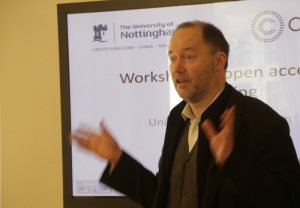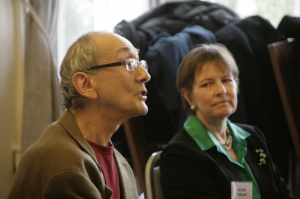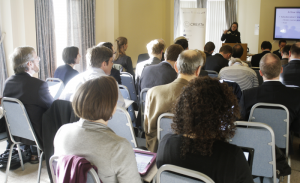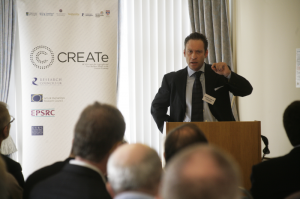Summary of the CREATe Workshop on Open Access Publishing
University of Nottingham
3 February 2014
by Ken Wilson (Doctoral Researcher, University of Nottingham School of Law)
To view the day’s programme, photographs, identified research gaps and copies of the day’s presentations, and to provide your own comments, please visit CREATe’s dedicated Open Access Publishing Stakeholders Event Resource Page.
Background to the Workshop
This workshop attempted to gather the different stakeholders in the field of open access publishing, especially open academic publishing, with the double aim of presenting the research gaps identified in Open Access Publishing: A Literature Review and eliciting reactions, comments, criticisms and finding new research questions and areas to explore both theoretically and empirically.
Introduction
 Martin Kretschmer, Director of CREATe, set the workshop in the context of CREATe’s mission to help the UK cultural and creative industries thrive and become innovation leaders within the global digital economy. To this end, he emphasised the importance of all stakeholders constructively formulating the way forward.
Martin Kretschmer, Director of CREATe, set the workshop in the context of CREATe’s mission to help the UK cultural and creative industries thrive and become innovation leaders within the global digital economy. To this end, he emphasised the importance of all stakeholders constructively formulating the way forward.
The Literature Review
At the outset, Giancarlo Frosio summarised the purpose, span, contents and limitations of the Literature Scope. His keynote was that the Review and workshop should be seen as an opportunity to map movement from the digital dark ages to the digital enlightenment in which the participation and co-operation of all stakeholders were essential for success.
Responses
In response there were prompt reminders that not all stakeholders were positive about Open Access. There were also doubts expressed as to ultimately how any system could be meaningfully regulated given the multitude of parties and interests involved.
A number of areas were highlighted that merited further clarification if not research. Crucially the library community had not been embraced in the workshop. The views of such a key player should be investigated, assessed and incorporated. Likewise, the tax-paying reading public. These were additional Research Gaps worth pursuing. The debate cannot be confined to the academy-funder-publisher-government/policy maker stakeholders matrix.
The debates revealed that clear and careful communication of terms and concepts is essential. This theme was to revisit many aspects of the workshop. For example, the meanings and unbundling of ‘mandate’ and ‘regulation’; the difference between Open Access Provision and Open Access Publishing; and between Gold and Green Open Access, as confusion can severely impede constructive discussions.
Research Gap I: Historical Perspective
 The discussion primer provided by John Willinsky’s presentation revealed an ongoing tension over the status that ought to be credited to academic works. Historically academic freedom, in a regulated environment (from monasticism onwards) had been integral to such works. This had often been inextricably linked with some form of advance external entrusted commercial support. The academic works so produced were then deemed by society to have enhanced value and status above what today would be termed ‘run-of –the-mill’ copyright productions. Author identity and reputation were vital to this value system. The overall purpose of such a regime was to help others learn. However, those concepts appear to have been lost in the modern age. History cannot of course, dictate current practices but we are all the poorer if we did not allow it to inform our debate.
The discussion primer provided by John Willinsky’s presentation revealed an ongoing tension over the status that ought to be credited to academic works. Historically academic freedom, in a regulated environment (from monasticism onwards) had been integral to such works. This had often been inextricably linked with some form of advance external entrusted commercial support. The academic works so produced were then deemed by society to have enhanced value and status above what today would be termed ‘run-of –the-mill’ copyright productions. Author identity and reputation were vital to this value system. The overall purpose of such a regime was to help others learn. However, those concepts appear to have been lost in the modern age. History cannot of course, dictate current practices but we are all the poorer if we did not allow it to inform our debate.
Responses
The importance of the Research Gap was apparent from respondent participation, confirming the continuing enquiry of how we assess the interaction of public funding, commerce, academic freedom, authorial reputation and readership all within the OA environment. These remain fruitful areas for additional study. They also interfaced with other Research Gaps evidencing the justification for a holistic approach to this subject.
A missed Research Gap was kindly supplied in later informal discussions with an attendee-mapping the history of the Open Access movement itself.
Research Gap II: Copyright Protection and Theory
This did not have an individually dedicated session. However, the significance of the issues flagged up in the Review: copyright incentives; which academic works should be covered by OA mandates; and issues surrounding the adequacy of the licences, (especially CC-BY) surfaced regularly throughout the day. Jerome Reichman’s preface, for example, straddled both Research Gaps II and III underscoring how expansive copyright and database law and para-copyright procedures (such as digital locks) inhibited the efficiency of scientific research and the development of open educational resources both nationally and internationally. While legislative ‘fixes’ were theoretically possible they were highly unlikely to be achieved in the foreseeable future. Consequently, voluntary not mandated solutions beyond copyright models, such as Open Knowledge Environments (OKEs), private ordering and community research platforms were emerging. Open Access though, did not have to be a homogenous system. There could be different models:-full open access to the world or open access limited to a particular research community. The latter was a rapidly growing model and merited further consideration.
Responses
In the subsequent discussion it emerged that publishers had adopted many initiatives and formats particularly on text and data-mining. Nevertheless, the breakdown of the Licenses for Europe consultations revealed the continuing and unresolved contention over legislated extended copyright exceptions versus licensing. There was also the need to explore the degree (and necessity) of the relationship and symmetry between legal issues and business models. Clearly, this whole area remains ripe for supplemental study and investigation.
Research Gap III: Economics and Business Models
A cluster of topics was gathered under this umbrella.
‘Academic Scholars, Reputation, Prestige and Careers’
Given that the rationale of this Gap was how academics adjust to OA, a number of challenges for consideration arose out of David Sweeney’s presentation. These spanned: the need for a balanced focus on the purpose and beneficiaries of research (the tax paying public as well as other researchers); looking for synergies and alignments, not conflict; assessing and changing perceptions (the academic author adding lustre to a publication and not vice versa), and evaluating and tackling the formal and informal factors that may bear on academic perceptions of prestige. Ultimately OA and the Mandates were about the widest possible dissemination of quality research.
Responses
Unresolved concerns were then expressed by participants. These embraced: assessment of the degree to which Universities and scholarly authors subsidised the publishing industry; evaluating the different motives and incentives between articles and monographs, complicated by sole or few publishers in certain subject areas; the fact that one size (of model and policy) across the academy was naïve; and the pressures and confusion arising out of unknowns in the final correlation between OA qualifying works and the REF. The version of publication deposited also had impact on the economics and business models involved. Mature reflection on all these queries may be relevant to the issues raised by the Research Gap as they affect how the scholarly author adjusts to OA.
‘Academic Publishing Market: Competition’
 Unfortunately as a result of illness Frank Mueller-Langer was unable to make his scheduled presentation. However, the significance of this Research Gap was confirmed by Tony Clayton’s solo opening of its consideration. He emphasised the importance of real competition (which was doubtful under the current regime); the necessity of examining and assessing all incentives and behaviours involved throughout the chain; and the unpacking and evaluation of the different elements of the publishing ecosystem. Such an endeavour required co-operation between the stakeholders to produce a model fit and appropriate for the digital era. It was not simply supply and demand.
Unfortunately as a result of illness Frank Mueller-Langer was unable to make his scheduled presentation. However, the significance of this Research Gap was confirmed by Tony Clayton’s solo opening of its consideration. He emphasised the importance of real competition (which was doubtful under the current regime); the necessity of examining and assessing all incentives and behaviours involved throughout the chain; and the unpacking and evaluation of the different elements of the publishing ecosystem. Such an endeavour required co-operation between the stakeholders to produce a model fit and appropriate for the digital era. It was not simply supply and demand.
The complexity of the issue (and thus the need for further studies and experiments with collaborative models) was authenticated by the subsequent publisher’s forum which had been convened to replace Frank Mueller-Langer’s talk. This panel was Richard Fisher (CUP), Philip Carpenter (Wiley), James Butcher (Nature), Rhodri Jackson (OUP), Rupert Gatti (Open Books), Tim Williams (Edward Elgar) and Richard Hart (Hart Publishing/ Bloomsbury). Although concerns were expressed from the floor about transparency, costs and disproportionate profit margins, the contributions from the business disclosed the range of models adopted and the variegated nature of their markets. While generally favourable to many aspects of Open Access, the industry reminded us of the international nature of their markets which were both digital and hard copy and the multiplicity of internalities and externalities that impacted on their operation. A fear was expressed that moving too rapidly to change the model through OA mandates could have unintended consequences and could lead to the disappearance of academic journal publishing. There was also an acknowledgement of endogenous and other barriers to new entrants to the market. Representatives accepted that the industry could improve communication to correct its perception problem.
Responses
Other participants voiced unease over the complexity and numbers of licences and contracts in the industry and also delays in approving articles and other publications, thus losing lead time and reducing if not impeding competition. Queries were raised as to whether the industry, despite its overtures, was ultimately merely protecting its lucrative subscription journal market and in some cases, double payment and unnecessary bundling.
‘Academic Publishing Market: Article Processing Charges’
The workshop had the benefit of two presentations on this topic.
The warning sounded by Gemma Hersch was that tunnel focus on APCs and cost may lead to misconstrued understandings and wrong policies. She re-iterated the variation of models, factors and markets emphasised earlier in the publishers’ forum. Thus a more rounded approach was essential. There was a gap for proper empirical studies on how markets formed and were forming rather than assuming that they were failing or dysfunctional. Metrics and discoverability should be part of this and not just detailed assessment of APCs. The suitability of the Creative Commons licences especially the CC-BY also invited further study particularly as to how they affected the publishing industry. Similarly, whether a fully OA model may produce a less competitive market.
Responses
There was though still strong disagreement from the floor once more centring on disproportionate profits, non-disclosure agreements, and anti-competitive bundling hence reinforcing the value of investigation of this Gap.
Alma Swan then shared the fruits of her many empirical studies in this area. APCs were only one mode of financing academic journal costs and indeed were not the dominant model. Others included Sponsorship, Advertising and Scholar sole/collaborative publishing. In the cases where APCs were payable the author paid in only the minority of cases, although a breakdown of those cases by discipline was yet to be researched. The average UK APC was in fact less than the breakeven figure of £1500 calculated in John Houghton’s research. In implementing OA it was imperative to avoid the big subscription deal morphing into a big APC deal if the system was to be sustainable.
She helpfully identified a number of additional Research Gaps including:
- The effect of Green OA
- The extent and economic effect of ‘double dipping’
- The cultural and academic issues around scholar-led publishing
- Other business models such as price-fixing and external regulation
- The REAL costs (and the need for them) of APCs
- The assessment of the value of the different elements of publishing – e.g. peer-review management, editorial role, dissemination, enhancements to the final product and ongoing innovation – was not monolithic but a series of individual steps.
Responses
The need for improved (preferably clear standard form) publishers’ contracts vis-à-vis uses of institutional repositories and improved metrics for downloads and citations were among the major issues raised from the floor, all of which were relevant to the calculation of value for money in considering APCs.
‘Academic Publishing Market: OA Book Publishing
Emerging from Frances Pinter’s discussion prelude were memorable phrases such as ‘the book market has always been a hard market to crack’, ‘libraries are migrating from collecting to connecting’ ‘publishing is about filtering, framing and editing’ and of OA-‘the beauty is the pull rather than the push’. While books have and always will be different than journals, the term ‘book’ itself was too broad and had to be unpacked into its different manifestations. Apparently there are approximately some 200 different digital formats for ‘long form’ works. This opens up a host of issues over markets, copyright, licensing and other contracts. For her, there was a case to revisit the traditional justifications for copyright and appraise their relevance and applicability to incentives, motives and rewards in the digital and OA age. Her research also indicated that some 76% of authors want more protection for their work than just a CC-BY licence. There was therefore an opening for experimentation with different models and she illustrated the point by reference to nine such existing models.
Responses
There was confirmation of formats for the same work being utilised by publishers some on a bare CC-BY licence (free on-line to read, with small fee for a PDF copy or larger fee for Print on Demand (POD) traditional hard/softback book, minimising costs and maximising access). For others there were unanswered questions as to whether book publishing should be rationed or if OA could save threatened academic disciplines in some parts of Arts, Humanities and Social Sciences.
Research Gap IV: OAP Mandates
‘OA Mandate Policies: Compliance and Enforcing Mechanisms’
Once more there were two complimentary presentations addressing this Research Gap.
 For Stevan Harnad, this issue was too often clouded by myths, wrong perceptions and misunderstandings. The current mandates were simply about making quality peer-reviewed scholarly articles free to read online. It was not rocket science but raincoat science-it was raining therefore put on your raincoat-no excuses, prevarications or obfuscations. Such excuses had delayed and misconstrued Green OA for more than a decade. Consequently, Green OA had been deemed a failure without proper testing. As a result, a compromised system, allowing for embargoes, had to be accommodated as a necessary step on the journey to proper full Gold OA. The HEFCE mandates would ensure that the route to that goal would be secured. The mandates did not include perceived ‘impact factor’ of where an article was published-that may be an academic institutional requirement but it was not a mandate one. In brief, a mandate’s obligation to deposit immediately in a Repository can easily be married with embargo constraints of commercial publishers to ensure that all the bases were covered. Additionally, assessment of mandate compliance procedures had already been initiated by Alma Swan and SPARC.
For Stevan Harnad, this issue was too often clouded by myths, wrong perceptions and misunderstandings. The current mandates were simply about making quality peer-reviewed scholarly articles free to read online. It was not rocket science but raincoat science-it was raining therefore put on your raincoat-no excuses, prevarications or obfuscations. Such excuses had delayed and misconstrued Green OA for more than a decade. Consequently, Green OA had been deemed a failure without proper testing. As a result, a compromised system, allowing for embargoes, had to be accommodated as a necessary step on the journey to proper full Gold OA. The HEFCE mandates would ensure that the route to that goal would be secured. The mandates did not include perceived ‘impact factor’ of where an article was published-that may be an academic institutional requirement but it was not a mandate one. In brief, a mandate’s obligation to deposit immediately in a Repository can easily be married with embargo constraints of commercial publishers to ensure that all the bases were covered. Additionally, assessment of mandate compliance procedures had already been initiated by Alma Swan and SPARC.
From the perspective of a representative body of 52 independent research funders (Science Europe), Eva Hoogland then welcomed the Literature Review with its stress on complimentary and holistic approaches particularly in relation to Research Gaps III.3.3.1 & III.3.3.2 (APCs and Regulation) and IV (OA Mandate Compliance and Enforcing Mechanisms and Academic Freedom). Assessment and evaluation in these areas remained valid and important. There was support for Gold OA subject to proper quality control and clear transparent costs. The tension between OA and Academic career advancement would benefit more from a mission of explanation rather than in-depth study.
Responses
Responses from the floor revealed a far from straightforward explanation for lack of academic authorial engagement with OA ranging from ignorance, administrative barriers, time pressure from other commitments through to miscellaneous fears (including that of breaching agreements with publishers or contracts of employment, and generally of the ‘unknown’). There was a perception of there being too much stick and not enough carrot. Conversely, OA Mandates could be seen as giving academics permission to do things that would otherwise be curtailed by publishing and institutional restraints. Stevan Harnad helpfully pointed delegates to appropriate niche software and systems such as the University of Liege’s ORBi facility which were designed to minimise the time, effort and technicalities involved and which were ideal tools for a speedy and easy compliance with the mandates.
There did however remain doubts over the final terms of the different UK mandates (e.g. HEFCE, RCUK,UK Universities etc) and how consistent they would be with each other. Whether privately funded and/or international co-operative research -would qualify or whether they could be excluded were mentioned as concerns.
Concluding remarks
 In bringing proceedings to a close, Estelle Derclaye and Giancarlo Frosio emphasised a number of points. Fruitful areas for learning, reflection and additional research gaps had emerged. In the main, OA generally seems to be a good thing at least for academic outputs but how we do it and how we experiment with it are crucial. There was certainly a need for a communication mission. The ‘ecosystem’ or in other words, the economic structure of academic publishing, especially in relation to OA academic publishing and all that it embraced should be borne in mind and elaborated on further. The possibility of an ongoing discussion forum on the CREATe website was suggested.
In bringing proceedings to a close, Estelle Derclaye and Giancarlo Frosio emphasised a number of points. Fruitful areas for learning, reflection and additional research gaps had emerged. In the main, OA generally seems to be a good thing at least for academic outputs but how we do it and how we experiment with it are crucial. There was certainly a need for a communication mission. The ‘ecosystem’ or in other words, the economic structure of academic publishing, especially in relation to OA academic publishing and all that it embraced should be borne in mind and elaborated on further. The possibility of an ongoing discussion forum on the CREATe website was suggested.
